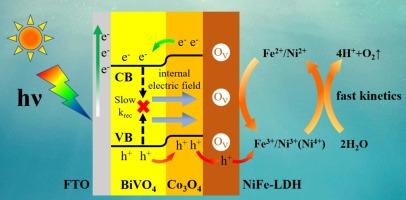Functional coupling hole transport and extraction units over BiVO4 for efficient solar-to-hydrogen conversion
IF 10.9
1区 工程技术
Q1 ENERGY & FUELS
引用次数: 0
Abstract
Photoelectrochemical (PEC) water splitting based on BiVO4 nanostructures is largely limited by the fast recombination of charge carriers and the low oxygen evolution reaction (OER) kinetics. To enhance PEC performance of BiVO4, combining hole transport units and hole extraction units is a simple and effective methods. In this work, Co3O4 and NiFe layered double hydroxide (NiFe-LDH) were coupled to promote bulk-phase charge separation and solid–liquid interface transfer, which accelerated OER kinetics on surface of target photoanodes. Moreover, p-n heterojunction between BiVO4 and Co3O4 suppressed charge recombination and promoted charge transfer, resulting in an effectively enhanced photocurrent density and applied bias photon to current efficiency (ABPE). To facilitate involvement of photogenerated holes in OER, BiVO4/Co3O4 electrodes are coated with NiFe-LDH as a hole extraction layer using a straightforward chemical bath deposition (CBD) technique. Successful fabrication of NiFe-LDH with rich oxygen vacancies significantly improves transport of charge carriers and provides many activity sites on the electrode surface. The optimized BiVO4/Co3O4/NiFe-LDH photoanode displayed a photocurrent density of 5.41 mA cm−2 at 1.23 VRHE with an ABPE of 1.08 % at 0.86 VRHE under light. These values are approximately 4.66 and 8.30 times higher than those of BiVO4 photoanodes. This study presents a powerful approach to enhance charge separation and transport in BiVO4-based photoanodes by functionally coupling hole transport and extraction units, thereby enabling efficient solar-to-hydrogen conversion.

在 BiVO4 上耦合空穴传输和萃取单元的功能,实现高效的太阳能-氢气转换
基于 BiVO4 纳米结构的光电化学(PEC)水分离主要受限于电荷载流子的快速重组和低氧进化反应(OER)动力学。为了提高 BiVO4 的 PEC 性能,将空穴传输单元和空穴萃取单元结合起来是一种简单有效的方法。在这项工作中,Co3O4 和镍铁层双氢氧化物(NiFe-LDH)被耦合在一起,以促进体相电荷分离和固液界面转移,从而加速了目标光阳极表面的 OER 动力学。此外,BiVO4 和 Co3O4 之间的 p-n 异质结抑制了电荷重组,促进了电荷转移,从而有效提高了光电流密度和外加偏置光子电流效率(ABPE)。为了促进光生空穴参与 OER,BiVO4/Co3O4 电极采用简单的化学沉积(CBD)技术镀上了 NiFe-LDH 作为空穴萃取层。成功制备出具有丰富氧空位的 NiFe-LDH 可显著改善电荷载流子的传输,并在电极表面提供许多活性位点。优化后的 BiVO4/Co3O4/NiFe-LDH 光阳极在 1.23 VRHE 下的光电流密度为 5.41 mA cm-2,在 0.86 VRHE 下的 ABPE 为 1.08%。这些数值分别是 BiVO4 光阳极的约 4.66 倍和 8.30 倍。这项研究提出了一种强有力的方法,通过在功能上耦合空穴传输和萃取单元来增强基于 BiVO4 的光阳极中的电荷分离和传输,从而实现高效的太阳能-氢转换。
本文章由计算机程序翻译,如有差异,请以英文原文为准。
求助全文
约1分钟内获得全文
求助全文
来源期刊

Energy Conversion and Management
工程技术-力学
CiteScore
19.00
自引率
11.50%
发文量
1304
审稿时长
17 days
期刊介绍:
The journal Energy Conversion and Management provides a forum for publishing original contributions and comprehensive technical review articles of interdisciplinary and original research on all important energy topics.
The topics considered include energy generation, utilization, conversion, storage, transmission, conservation, management and sustainability. These topics typically involve various types of energy such as mechanical, thermal, nuclear, chemical, electromagnetic, magnetic and electric. These energy types cover all known energy resources, including renewable resources (e.g., solar, bio, hydro, wind, geothermal and ocean energy), fossil fuels and nuclear resources.
 求助内容:
求助内容: 应助结果提醒方式:
应助结果提醒方式:


